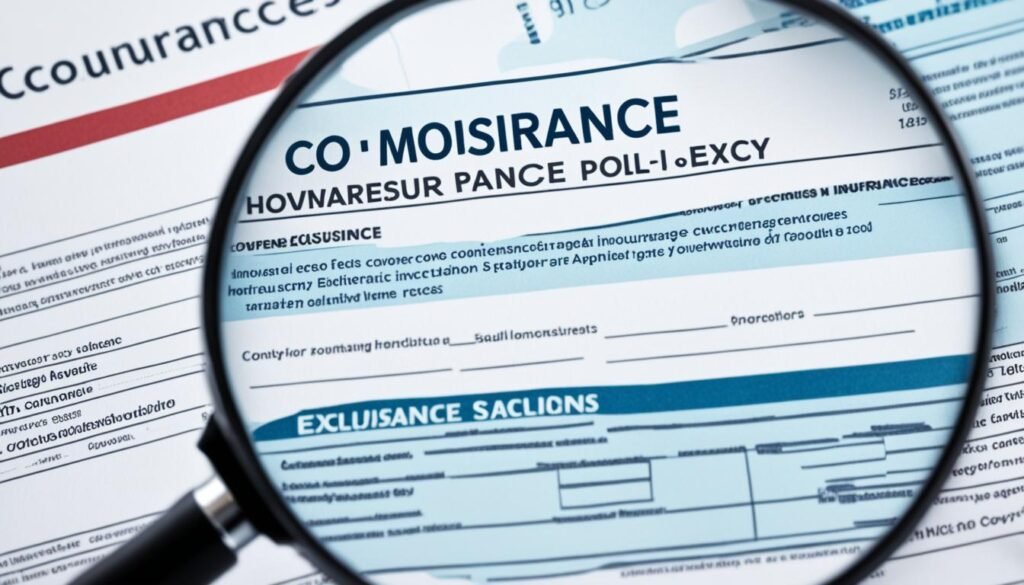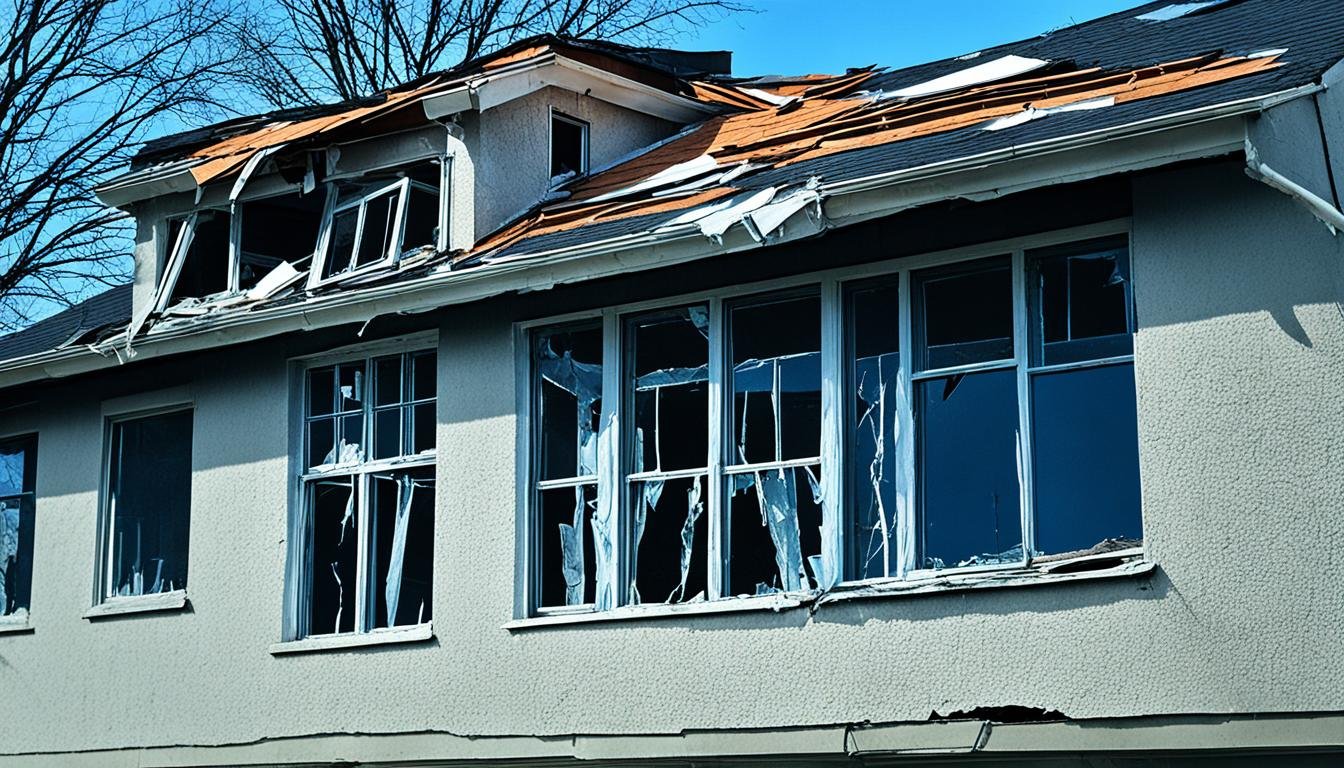Accidents can happen, and knowing how to file a home insurance claim is key. Whether it’s a burst pipe, a fallen tree, or a break-in, you must follow the right steps. This guide will help you through the process, from reporting the incident to negotiating the settlement.
Key Takeaways
- Report the incident to your insurance company quickly to begin the claims process.
- Document the damage well with photos and receipts to back up your claim.
- Do what you can to stop further damage, like temporary repairs, to lessen your losses.
- Know what your policy covers and your deductible to understand the claims process better.
- Talk about the settlement with your insurance company if their first offer doesn’t meet your expectations.
Report the Incident Promptly
When you file a home insurance claim, time is crucial. The faster you report the incident and contact your insurance company, the quicker your claim will be handled. This means you can start fixing your home sooner.
Contact Your Insurance Company
You can usually submit home insurance claims online, through an app, via your agent, or by calling the company. It’s important to report a claim as soon as possible. After you insurance claim is received, your insurer will give you a claim number and send an adjuster to check the damage.
Soon, the insurance company will make an initial payment — minus your deductible — to cover repair costs. If your claim is due to storm damage, many other homes might also be affected. This means there will be more claims and a high demand on your insurer. Submitting a claim quickly can help you get ahead in the claims process.
The sooner you file your claim, the faster you can fix your home. Don’t wait to report the damage or report the issue to your insurance company.
Document the Damage

When you file a home insurance claim, it’s key to document the damage well. This helps support your claim and makes sure you get the full payout from your insurance company.
Begin by taking clear photos of the damage. Show pictures of any affected areas, labels, and model numbers, especially for costly items. These photos act as proof of how much damage there is and are crucial in the claims process.
Also, make a detailed list of all the items damaged. This home inventory should have a full list of the damaged goods, including what they are, when you bought them, and how much they cost. Having this list of damaged items helps you catalogue the damage and gives your insurer the proof they need.
It’s vital to document the damage thoroughly to back up your insurance claim. The more details you give, the higher your chances are of getting a fair and full payout from your insurance company.
The more information the insurer has, the better — so try to get pictures of labels and model numbers, especially for more expensive items.
Prevent Further Damage

After filing an insurance claim for home damage, it’s key to prevent further damage right away. This means making temporary repairs to stop leaks, boarding up broken windows, or covering other areas at risk.
Even if you must wait for an insurance adjuster to check the damage, starting temporary repairs can save you time and money. Just remember to keep receipts for any materials or labor costs related to these temporary repairs.
Keep Receipts
It’s vital to document your expenses when filing a home insurance claim. Keep receipts for any buys made to stop further damage, board up your home, or cover damage until the adjuster comes. These receipts can be part of your claim for reimbursement.
By documenting expenses and keeping receipts, you can make sure you get the right compensation for the steps you took to prevent further damage to your home. This careful approach can make the claims process easier and boost your chances of a good settlement.
“Taking prompt action to prevent further damage is crucial when filing a home insurance claim. The more you can do to stop the problem from escalating, the better.”
Home Insurance Claim

Filing a home insurance claim is key to getting your home and stuff fixed or replaced after a covered event. The claims process means documenting the damage, telling your insurance about it, and working with an adjuster to see how much you lost. By doing it right, you make sure you get what you’re owed from your homeowners insurance policy.
The first thing in the claims process is to file a home insurance claim with your company fast. You can do this over the phone, online, or by seeing your local agent. You’ll need to give them details about what happened, like when, where, and what got damaged.
- Document the damage well by taking photos and listing what’s lost or damaged.
- Make sure your property is safe, and keep receipts for any quick fixes or costs you pay.
- Work well with the adjuster on your claim, giving them any extra info or papers they ask for.
- Look at your policy well to know what you’re covered for and make sure you get everything you should.
| Key Steps in the Insurance Claim Process | Explanation |
|---|---|
| Report the Incident Promptly | Tell your insurance company right away to file a claim, giving them all the details about what happened. |
| Document the Damage | Take pictures and list what’s lost or damaged to back up your claim. |
| Prevent Further Damage | Keep your property safe and fix any urgent problems to stop more damage, and save receipts for later. |
| Work with the Adjuster | Help the insurance adjuster on your claim by giving them any info or papers they need. |
| Understand Your Policy | Look at your homeowners insurance policy well to make sure you get all the coverage you should. |
By doing these steps, you can file a home insurance claim right and boost your chances of getting a fair and quick settlement from your insurance company.
Prepare for the Adjuster

Your insurance company will send an insurance adjuster to check the damage and handle your claim. This person will talk to you a lot, so getting ready for their inspection and assessment is key.
Before the adjuster comes over, make sure you document the damage well. Use photos, videos, and write down what happened. This will help the adjuster see how bad the damage is and make sure you get a fair deal.
- Make a detailed list of what’s damaged or stolen, including when you bought it and how much it was worth.
- Have any receipts or repair quotes ready, as they’re important for your claim.
- Be ready to answer the adjuster’s questions about what happened and give them any extra info they ask for.
The adjuster works for the insurance company, not just for you. It’s important to speak up for yourself and make sure your needs are met during the claims process. Think about getting a public insurance adjuster to help with your claim and talk to the insurance company for you.
By getting ready for the adjuster’s inspection and assessment, you can make the claims process smoother and more likely to end well. This way, you’ll have a better chance of getting a fair settlement for your home’s damages.
Understand Your Policy

Understanding your insurance policy is key to filing a successful claim. Take time to review your policy terms and policy details. This ensures you know what is and isn’t covered. Make sure you understand your coverage limits, deductible, and any exclusions.
Review Your Coverage
Looking over your homeowners insurance policy helps you see if your damage is covered. Start by learning about your coverage limits. This is the most your insurer will pay for a covered loss. Also, get to know your deductible. This is what you pay first before your insurance covers the rest.
Knowing your policy before an issue happens helps you deal with claims better. It lets you know what’s not covered. This way, you can make sure you get the full payout you deserve from your homeowners insurance policy.
“Knowing the terms of your policy ahead of time will help you navigate the claims process more effectively and ensure you receive the full payout you’re entitled to.”
Negotiate the Settlement

If you’re not happy with the payout from your insurance company, don’t give up. You can negotiate the settlement. Start by sharing your concerns and explaining why you think you should get more money, with solid proof. If they say no, think about hiring an appraiser or an insurance adjuster to challenge their claim estimate.
If nothing works, you might need to file a complaint with your state’s insurance department or take legal action. This could help you get the claim settlement you deserve.
Dealing with insurance claims can be tough, but you can negotiate the settlement and get fair pay. Being persistent and showing strong evidence can help you dispute a claim and get the money you need for repairs or replacing what was damaged.
| Negotiation Strategies | Potential Outcomes |
|---|---|
|
|
Negotiating with the insurance company is key to getting the right compensation. By being persistent, showing proof, and looking at all your options, you can settle your claim. This way, you’ll get the payout you need to fix your home.
Hire Reputable Contractors

Choosing the right contractor for home repairs is key. Don’t rush into hiring the first person who comes to your door after a disaster. Always research reputable contractors and check their qualifications before signing anything.
Avoiding Fraud
After a disaster, beware of fraudulent contractors. They might offer low prices but lack the right licenses, insurance, and skills. To dodge contractor fraud, watch out for these signs:
- Contractors who rush you into making a decision or ask for cash upfront
- Contractors without a real business address or hard to contact
- Contractors with unclear estimates or contracts
- Contractors with no references or online reviews
By carefully choosing contractors known for quality work and happy customers, you can ensure your repairs are done right. This way, you avoid the problems and costs of fraudulent contractors and scams.
| Reputable Contractors | Fraudulent Contractors |
|---|---|
| Licensed and insured | No licenses or insurance |
| Positive reviews from previous customers | Few or no references |
| Clear and transparent estimates | Vague or misleading estimates |
| Experienced and qualified | Lack of relevant expertise |
File Additional Claims if Needed

Sometimes, you might need to file additional claims if you find more damage or if the first settlement didn’t cover all repair costs. Filing multiple claims might be needed, but remember, doing so too often can raise your insurance rates. This could make finding affordable coverage later on harder.
When thinking about a supplemental claim or filing a new claim, it’s key to work with your insurance company and adjuster closely. They can tell you if you need to re-open a claim and help you through the process. Make sure to document any new or missed damage well to support your claim history. This ensures you get a fair settlement that covers the claim impact.
“It’s essential to be proactive and work closely with your insurer when filing additional claims. This will help ensure you receive the full coverage you’re entitled to without jeopardizing your future insurance options.”
By taking these steps, you can handle the complex process of filing additional claims well. This way, you can get the compensation you need to fix your home fully. Remember, being open and honest with your insurance company is crucial for a good outcome.
| Scenario | Action | Considerations |
|---|---|---|
| Discovering new damage | File a supplemental claim | Thoroughly document the new damage and work with the adjuster to ensure it’s covered. |
| Initial settlement was insufficient | Re-open the claim | Provide evidence to support the need for additional coverage and negotiate with the insurer. |
| Multiple claims within a short period | Carefully evaluate the claim history and claim impact | Be mindful that frequent claims can affect your insurance rates and coverage options in the future. |
Also Read : Eco-Friendly Financing: Supporting Green Loans and Insurance Products
Conclusion
Filing a home insurance claim can seem tough, but this guide makes it easier. By following the steps, you can get the payout you deserve from your insurer. Start by reporting the incident quickly and document the damage well.
Then, make temporary repairs and work closely with the insurance adjuster. Each step is important for a smooth claim process and getting full compensation.
It’s also key to know your policy well, negotiate the settlement, and pick reliable contractors. These steps help protect your property and your finances. They also help fix your home to its pre-incident state.
So, the main tips for a successful home insurance claim are: report the incident fast, document the damage, stop further damage, work with the adjuster, know your policy, and choose trustworthy contractors. By doing these, you can go through the insurance claim process confidently. You’ll make sure you get the home insurance claim payout you deserve.
FAQs
Q: How do I file a home insurance claim?
A: To file a home insurance claim, you typically need to contact your insurance company and provide details about the damage or loss. They may ask you to fill out a claim form and possibly provide additional documentation such as a police report or home inventory.
Q: What should I do if my home is damaged?
A: If your home is damaged, it is important to document the damage by taking photos and videos. Contact your insurance company as soon as possible to start the claims process.
Q: How long do I have to file a home insurance claim?
A: The timeframe to file a home insurance claim varies depending on your insurance policy, but it is generally recommended to file a claim as soon as possible after the damage occurs.
Q: Should I hire a public adjuster to help with my home insurance claim?
A: Hiring a public adjuster can be beneficial if you are not familiar with the claims process or if you want someone to represent your best interests when dealing with the insurance company.
Q: What factors can impact my home insurance claim?
A: Various factors can impact your home insurance claim, such as the extent of the damage, the terms of your policy, and whether you have a history of filing multiple claims.
Q: What are some of the best homeowners insurance companies to file a claim with?
A: Some of the best homeowners insurance companies known for their responsive claims process include [list of reputable companies]. It’s important to research and choose a company that suits your needs.
Q: How will my claim money be paid out?
A: The insurance company will typically pay out your claim money either through a direct deposit, a physical check, or other agreed-upon methods outlined in your policy.
Source Links
- https://www.nerdwallet.com/article/insurance/home-damage-claims
- https://www.marketwatch.com/guides/insurance-services/how-to-file-a-home-insurance-claim/
- https://insurance.mo.gov/consumers/home/documents/ClaimDisaster-Missouri.pdf






